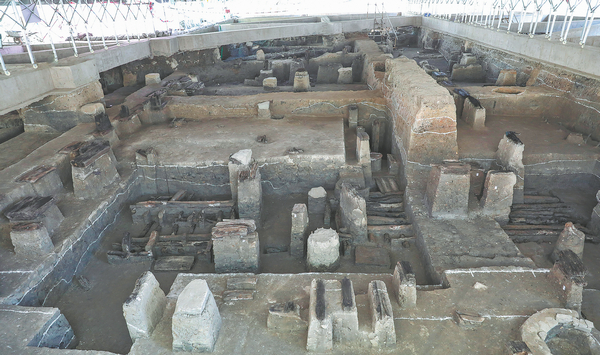New finds indicate legendary state in Shaoxing

The Jizhong Site under excavation covers nearly 3,000 square meters in Zhejiang province's Shaoxing ancient city, the site of high-level buildings of an important Yue state capital during the Warring States Period (475-221 BC). CHINA DAILY
The latest archaeological discoveries in Shaoxing in Zhejiang province appear to confirm records of the existence of a legendary state millennia ago.
Complex large-scale foundations from the Yue State, which existed during the Warring States Period (475-221 BC), have been discovered for the first time in Shaoxing ancient city, which is known to have been the site of an important Yue capital, scholars explained at a recent news conference at the National Cultural Heritage Administration in Beijing.
The Jizhong Site in Shaoxing was discovered during a construction project at the Shaoxing Jishan High School last year. It has yielded results over the past five months since archaeological efforts started in February. The area under excavation covers nearly 3,000 square meters.
Li Longbin, director of the Shaoxing Institute of Cultural Relics and Archaeology, says that the remains of wooden foundations from the Warring States Period and the Han Dynasty (206 BC-AD 220) are densely distributed across the site. The later Han complex was built on the site of an earlier structure covering an area of 2,385 square meters.
Based on records, archaeologists believe that the Warring States Period relics are from the Yue, a state that ruled part of today's Zhejiang and Jiangsu provinces and Shanghai.
A large number of tiles have been found from both periods, which imply the existence of important buildings. "From the Warring States Period to the Han Dynasty, only important buildings had tiles. The large number and types of tiles unearthed clearly indicate that the site was originally home to important buildings," says Li.
Moreover, archaeologists have found that the original complexes were built on high platforms, indicating they were government offices since at the time only government buildings were elevated.
The complexes from both periods show evidence of buried wooden foundations and buildings on platforms. "This shows an innovative way of building that probably combines the use of traditional Yue state stilt houses and Central Plains-style buildings," says Li.
"I believe this is a way of construction invented by the Yue prevented their buildings from settling. …Then when the Han rulers built there, they inherited the Yue methods," he adds.
Qin Dashu, an archaeology professor at Peking University, says that the earliest foundations are well-preserved, and display characteristics very different to contemporaneous structures in northern China, and thus play an important role in the history of the country's architecture.
According to Li, archaeologists have excavated a few Yue sites, particularly tombs, but all the earlier sites were located outside Shaoxing ancient city, which is part of the modern Shaoxing, and only the new site is located within the confines of the ancient city.
According to historical literature, King Goujian assumed the Yue throne in 496 BC, and three years later, the state was invaded and defeated by a neighboring power, the Wu, who took Goujian captive and held him until 490 BC.
Following his release, Goujian built a new capital in Shaoxing ancient city and is said to have lived a humble life. He slept on piles of firewood and hay, used his weapons as a pillow, and hung bitter gall in his home, licking it every day to remind himself of the bitterness and shame of being captured. Through much resolve and immense effort, he finally built up Yue strength and defeated Wu 17 years later.
"Carbon dating shows that the site dates to 2,500 years ago, and stands as testimony to the recorded history of King Goujian establishing his capital in Shaoxing ancient city," says Li.
"As a result, it's a big discovery since it fills in a blank about why no Yue state relics had been found within Shaoxing ancient city, and offers clues to the study of the layout of the capital," he adds.
Artifacts from later dynasties have also been found at the site, including from the Six Dynasties (222-589), and the Sui (581-618), Tang (618-907) and Song (960-1279) dynasties.
One standout find is of part of a tablet written by Southern Song Dynasty (1127-1279) historian and poet Lu You, which was unearthed at the site last year, alongside a large number of building units and ceramics found more recently, which together indicate that the site may have been Shaoxing's guanxue, a type of government-sponsored educational institution for nurturing talent during the Song Dynasty.
"The Jizhong Site boasts a wealth of artifacts. The area is full of foundations of buildings that were in use for a long time," says Li.
"These buildings, spanning different eras, exhibit the features of high-level architecture, providing evidence of ancient Shaoxing's role as a political, economic and cultural hub in the southeastern region of China," he adds.


 Connecting Global Perspectives, Focusing on Zhejiang's Practices
Connecting Global Perspectives, Focusing on Zhejiang's Practices Shaoxing Showdowns
Shaoxing Showdowns Zhejiang: A Decade of Progress
Zhejiang: A Decade of Progress